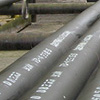

Hunan Standard Steel Co.,Ltd es uno de los miembros de Husteel Industry Group, como fabricante profesional de tuberías y accesorios de tubería de acero dulce, que tiene un sistema completo de producción ... Más
Fábrica GrupoNotes of stainless steel quality inspection process
fecha:2017-06-27
Vista:2234
1. Stainless steel plate if the surface of the workpiece is attached with oil, the thickness of the scale of the oil attachment and the thickness and composition of the other parts are different and carburizing. The carburized part of the base metal will be severely attacked by acid. Heavy oil burner when the initial combustion of oil droplets, if attached to the workpiece, the impact is also great. Therefore, the operating staff do not touch the stainless steel parts directly, do not make the workpiece stained with new oil.
2, The surface of the workpiece if the cold processing of lubricating oil, etc., must be in the trichlorethylene degreasing agent, caustic soda solution in the full degreasing and then rinse with warm water, and then heat treatment.
3, Stainless steel if the surface of debris, especially organic or gray attached to the workpiece, the heating of course, will have an impact on the scale.
4, The difference between the atmosphere of stainless steel furnace atmosphere in the local different, the formation of a scale will change, which is caused by acid pickling after the reasons for uneven. Therefore, in the heating, the furnace parts of the atmosphere must be the same.
5, The workpiece in direct contact with the heating, must be fully dried to use. However, after drying, such as placed at room temperature, in the case of high humidity, the water will still condense on the surface of the workpiece. So, it is best to dry before use.
Before the remnants of the scale, after heating the remaining parts of the scale and the site of no scale, there will be the thickness of the scale and the composition of the difference, resulting in pickling after the surface is not uniform, so not only pay attention to the final heat treatment, but also pay full attention to intermediate heat treatment and pickling. The resulting oxide is different. Therefore, it is necessary to make the treatment member not directly in contact with the flame port during heating.
2, The surface of the workpiece if the cold processing of lubricating oil, etc., must be in the trichlorethylene degreasing agent, caustic soda solution in the full degreasing and then rinse with warm water, and then heat treatment.
3, Stainless steel if the surface of debris, especially organic or gray attached to the workpiece, the heating of course, will have an impact on the scale.
4, The difference between the atmosphere of stainless steel furnace atmosphere in the local different, the formation of a scale will change, which is caused by acid pickling after the reasons for uneven. Therefore, in the heating, the furnace parts of the atmosphere must be the same.
5, The workpiece in direct contact with the heating, must be fully dried to use. However, after drying, such as placed at room temperature, in the case of high humidity, the water will still condense on the surface of the workpiece. So, it is best to dry before use.
Before the remnants of the scale, after heating the remaining parts of the scale and the site of no scale, there will be the thickness of the scale and the composition of the difference, resulting in pickling after the surface is not uniform, so not only pay attention to the final heat treatment, but also pay full attention to intermediate heat treatment and pickling. The resulting oxide is different. Therefore, it is necessary to make the treatment member not directly in contact with the flame port during heating.
























